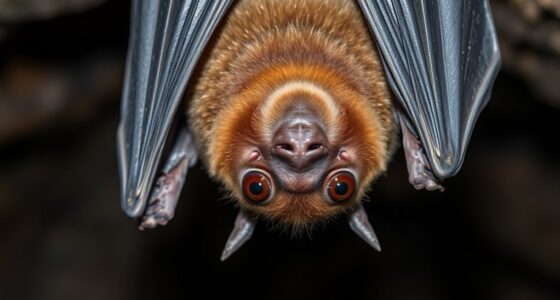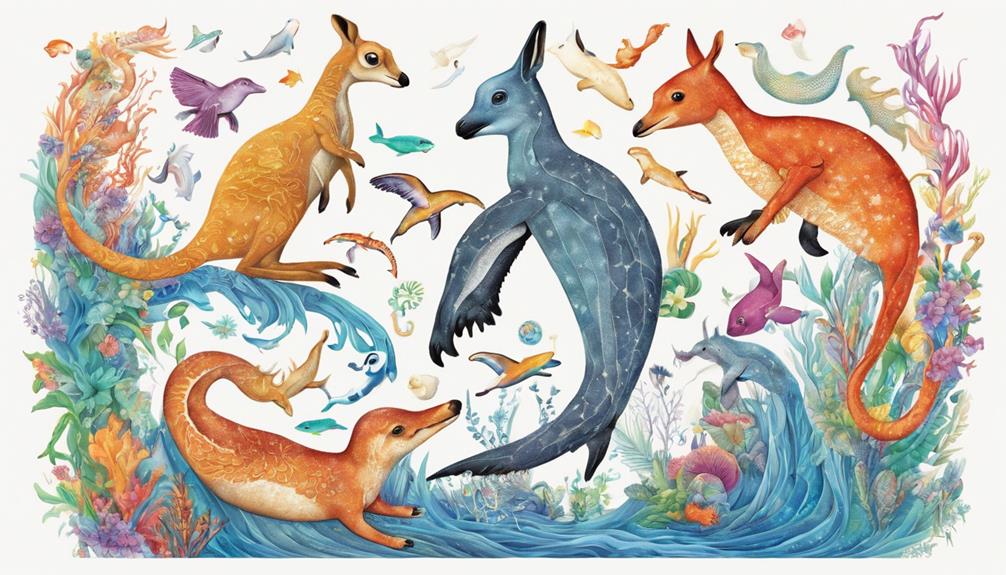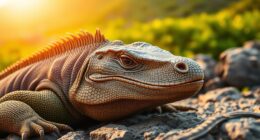Arctic animals have amazing adaptations to thrive in their harsh environment. They use insulation like thick fur and blubber to stay warm, while some change color for camouflage against predators. Many species adjust their migration patterns and hibernate to conserve energy during the long winters. Compact body shapes reduce heat loss, and social structures help them cooperate for survival. There's so much more to discover about how these incredible creatures adapt to their world.
Key Takeaways
- Arctic animals develop thick insulation, such as blubber in marine mammals and dense fur in land species, to conserve heat in extreme cold.
- Seasonal camouflage, like the color change in Arctic foxes and snowshoe hares, enhances survival by helping them blend into snowy environments.
- Migration patterns are shifting earlier due to climate changes, impacting breeding and food availability for species like caribou and eagles.
- Many Arctic species hibernate to conserve energy, utilizing built fat reserves and protected dens for survival during harsh winters.
- Compact body shapes and social structures in Arctic animals promote heat retention and cooperative strategies for hunting and resource sharing.
Insulation Adaptations of Arctic Animals
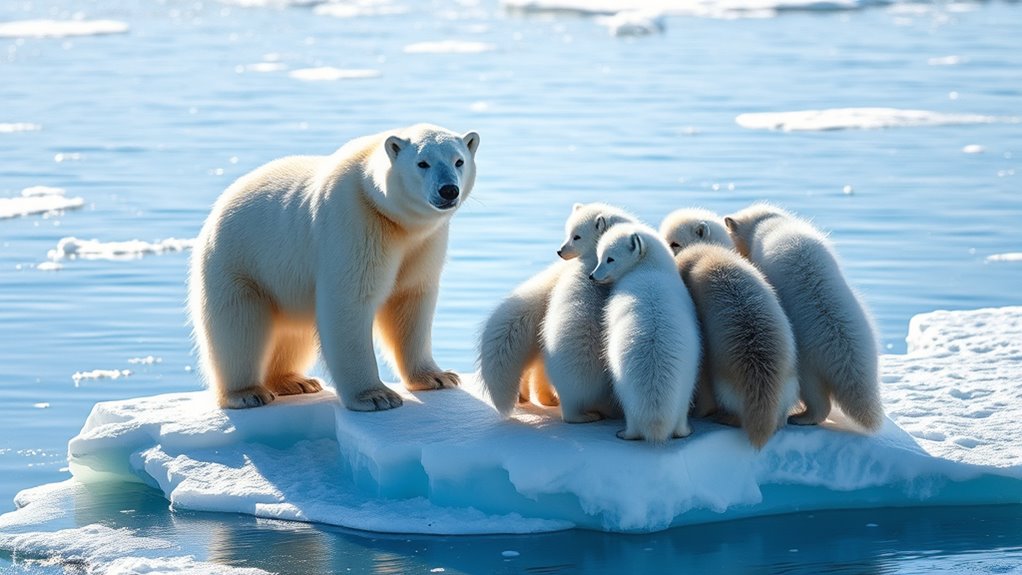
As temperatures plummet in the Arctic, animals have evolved remarkable insulation adaptations to survive the extreme cold. Many, like caribou and reindeer, have hollow guard hairs that trap air close to their bodies, enhancing warmth. Additionally, these adaptations are crucial for species to cope with limited food availability during harsh winters.
Muskoxen sport a thick underfur layer, making them resilient in frigid conditions. Arctic foxes showcase multilayered coats that keep them comfortable even at -70°C (-90°F), while their fur-covered foot pads minimize heat loss. Compact body shapes, seen in arctic hares, reduce heat loss further. Marine mammals, such as polar bears, rely on thick blubber for insulation and energy storage.
This combination of fur, blubber, and body structure guarantees these animals thrive despite the harsh Arctic environment.
Camouflage and Coloration Strategies
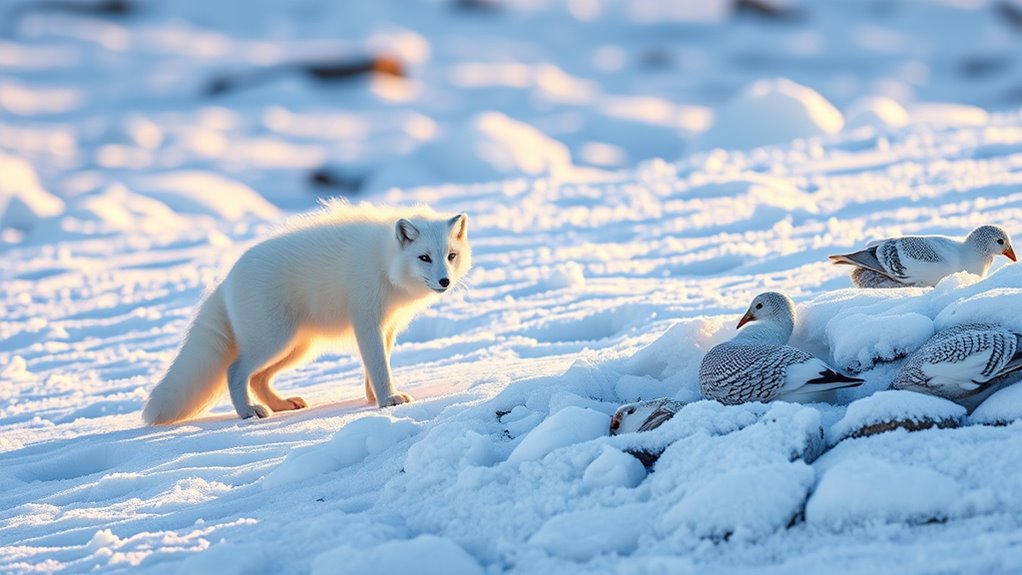
In the Arctic, many animals change their color with the seasons to blend seamlessly into their environment. This clever adaptation not only enhances their camouflage but also improves their chances of hunting and avoiding predators. Animals have evolved camouflage to better adapt in their specific habitats.
Seasonal Color Changes
Seasonal color changes in Arctic animals play an essential role in their survival, allowing them to blend seamlessly into their snowy environments.
For instance, Arctic foxes and snowshoe hares shift from brown to white in winter, enhancing their camouflage and helping them evade predators. Similarly, weasels, collared lemmings, and ptarmigans adapt their fur and feathers to match the snow, driven by genetic factors and photoperiod changes. This transformation not only aids in avoiding detection but also improves insulation, critical for energy conservation in harsh conditions. The colour change in these animals can take up to 10 weeks to complete, showcasing the intricate relationship between seasonal adaptations and survival strategies.
As climate change disrupts these patterns, understanding these seasonal adaptations becomes pivotal for the survival of these species in their changing habitats.
Blending With Environment
While the Arctic landscape may seem stark and barren, many animals have evolved remarkable strategies to blend into their environment. Polar bears and Arctic foxes showcase concealment with their white fur, effectively camouflaging against the snow. Other strategies, like disruptive coloration and mimicry, aren't as prevalent in this harsh climate. The need for effective camouflage is vital for avoiding predators and ensuring survival in such extreme conditions. Additionally, these animals often adjust to their surroundings by changing their coloration seasonally, much like how paint coverage rates can vary depending on environmental factors.
| Adaptation Type | Examples |
|---|---|
| Concealing Coloration | White fur in polar bears and foxes |
| Color Variations | Seasonal changes in fur color |
| Hunting Strategies | Stealthy approaches using camouflage |
| Environmental Matching | Blending with ice and snow |
These adaptations not only enhance hunting success but also help in avoiding predators, showcasing the remarkable resilience of Arctic wildlife.
Migration Patterns in the Arctic

As Arctic temperatures rise, animals are adjusting their migration patterns in response to changing seasons. You might notice that many species now migrate earlier, with some shifting their departure by about half a day each year.
This change can disrupt ecosystems, altering predator-prey interactions and resource availability. For instance, northern caribou are giving birth earlier to adapt, while eagles have begun migrating up to two weeks sooner over the past 25 years. Additionally, these shifts in timing could disrupt predator-prey relationships and have unknown impacts on species survival.
The shrinking sea ice and changing tundra also impact these migrations, forcing animals to adjust their routes.
The Arctic Animal Movement Archive tracks nearly a hundred species, providing essential data on these shifts and helping researchers understand the broader implications of climate change on Arctic ecosystems.
Hibernation and Energy Conservation
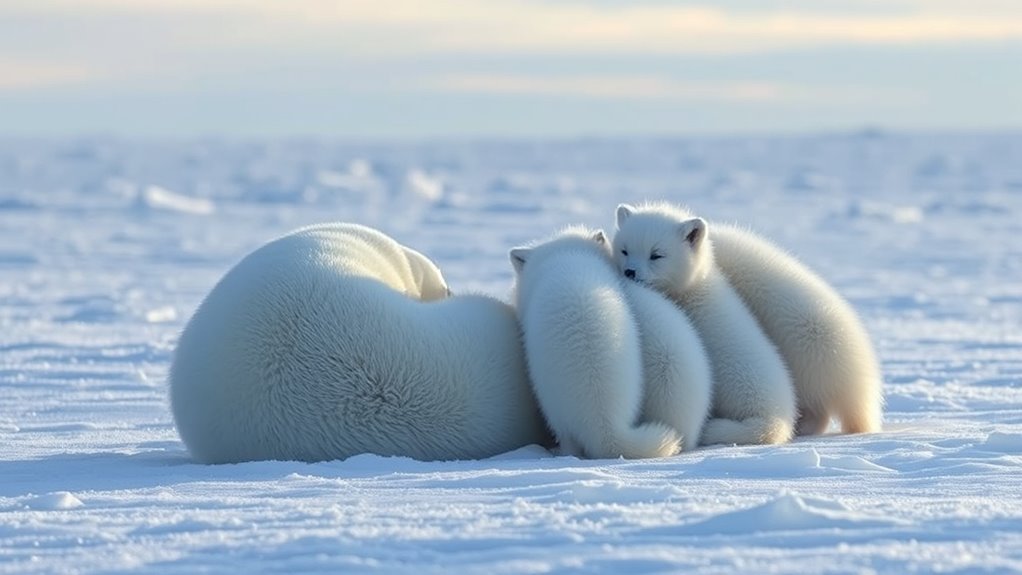
With migration patterns shifting due to climate change, Arctic animals have to rely on various survival strategies to cope with the harsh winter months.
As climate change alters migration patterns, Arctic animals adapt with unique survival strategies for the winter.
Hibernation is one of the most effective methods for energy conservation. By considerably lowering their heart rate, breathing rate, and body temperature, these animals can survive when food is scarce. Many species rely on fat reserves built during summer to sustain them throughout the hibernation period.
Here's how they manage it:
- Hibernation Duration: Arctic ground squirrels hibernate for about eight months.
- Safe Spaces: They hibernate in protected areas like dens or burrows.
- Fat Reserves: Many species build fat reserves during summer.
- Reduced Activity: Limiting physical activity helps conserve energy during winter.
These adaptations guarantee that Arctic animals endure the brutal cold while minimizing energy expenditure.
Body Shape and Size Adaptations

When you look at Arctic animals, you'll notice how their body shapes and sizes help them survive the extreme cold. Compact structures and heat-conserving features, like thick fur and blubber, play essential roles in keeping them warm. Additionally, their adaptations for movement allow them to navigate icy landscapes efficiently. Notably, the Arctic fox's compact body is designed to minimize heat loss, making it well-suited for life in freezing temperatures.
Compact Body Structures
In the frigid Arctic, compact body structures play an essential role in the survival of many animals. These adaptations help minimize heat loss and enhance energy efficiency.
You'll notice several features common among Arctic species:
- Compact Body Shape: Reduces surface area to minimize heat loss.
- Short Limbs: Decrease exposure to cold and conserve energy.
- Smaller Extremities: Features like rounded ears and short noses limit heat loss.
- Adaptive Body Size: Optimized for survival in harsh conditions.
These traits have evolved over time, enabling animals to thrive despite extreme environments. Additionally, these adaptations are crucial for Arctic marine mammals as they face challenges posed by climate change impacts.
Heat-Conserving Features
Many Arctic animals have evolved specific heat-conserving features that enhance their survival in extreme cold. For instance, many polar species, like walruses, boast rounded bodies that minimize heat loss by reducing exposed surface area.
You'll notice that animals such as polar bears have compact ears and tails, which help them retain warmth. Streamlined forms in marine mammals facilitate efficient swimming while conserving energy in icy waters. Additionally, polar bear insulation includes thick layers of blubber that provide insulation for species like bowhead whales. Large body sizes in animals reduce heat loss, while smaller mammals like lemmings utilize snow for insulation.
Adaptations for Movement
To thrive in the Arctic's harsh environment, animals have developed unique adaptations for movement that enhance their mobility and efficiency.
These adaptations are essential for traversing icy terrains and finding food. Here are some key features:
- Compact Body Forms: Many arctic animals, like foxes and hares, have compact bodies to minimize heat loss.
- Short Limbs: Shorter limbs in arctic foxes help conserve warmth while moving.
- Streamlined Bodies: Marine mammals, such as beluga whales, have streamlined shapes for efficient swimming, allowing them to navigate through sea ice.
- Large Size for Strength: Polar bears are larger to withstand harsh conditions and hunt effectively.
These physical traits allow Arctic animals to survive and thrive in one of the planet's most challenging environments.
Behavioral Adaptations for Survival

While facing the harsh conditions of the Arctic, animals have developed a range of behavioral adaptations that enhance their chances of survival.
For instance, Arctic foxes use stealthy hunting strategies, stalking and ambushing prey with finesse. They adapt their hunting efforts to seasonal prey availability, becoming more active during summer months. When food is scarce, scavenging carrion becomes vital. Their exceptional sense of smell enables them to detect hidden prey even under the snow.
To protect themselves, they construct insulated snow dens and curl up inside to conserve heat. Many Arctic animals reduce movement during extreme cold to save energy, while some enter hibernation-like states.
The Importance of Social Structures in Arctic Species

Social structures play an essential role in the survival of Arctic species, offering numerous advantages that enhance their chances against the harsh environment.
These structures foster cooperation and resource sharing, important for thriving in such extreme conditions. Here are some key benefits:
- Increased protection from predators through group dynamics.
- Cooperative hunting strategies, like those seen in arctic wolves, boost success rates.
- Shared resources help members survive during scarcity.
- Social learning allows individuals to adapt and refine survival strategies, particularly in habitats with resource-rich conditions that support larger group formations.
Understanding these social structures is fundamental for conservation efforts, ensuring that Arctic species can continue to navigate their changing environment effectively.
Frequently Asked Questions
How Do Arctic Animals Find Food During Winter Months?
During winter months, you'll notice that Arctic animals have unique strategies to find food.
Polar bears wait patiently by breathing holes to catch seals, while Arctic foxes scavenge leftovers or hunt small prey like lemmings.
Wolves work together to track and hunt larger animals like caribou.
Seals, on the other hand, maintain breathing holes in the ice, ensuring they can access air while also providing hunting opportunities for polar bears.
What Role Do Arctic Animals Play in Their Ecosystems?
Imagine a delicate balance, like a tightrope walker swaying in the frigid Arctic winds.
Arctic animals play pivotal roles in this ecosystem, acting as both predator and prey. They control populations, ensuring harmony among species, and contribute to nutrient cycling, redistributing resources essential for survival.
These creatures create habitats and guide migration patterns, threading their existence through the fabric of life. Without them, the tapestry of the Arctic ecosystem would unravel, losing its vibrant complexity.
How Do Climate Changes Impact Arctic Animal Adaptations?
Climate change impacts Arctic animal adaptations by forcing you to adapt more rapidly to shifting conditions.
As temperatures rise, you notice changes in food availability and migration patterns. Some species may breed earlier or shift their ranges, while others struggle to keep pace.
With altered seasonal cues, mismatches between predator and prey become common, challenging your survival. The fast pace of these changes tests your ability to adapt, threatening the delicate balance of your ecosystem.
What Are the Breeding Habits of Arctic Animals?
Imagine the icy winds whispering secrets of love beneath the shimmering auroras.
In the Arctic, polar bears mate in spring, while emperor penguins set out on long journeys to their breeding grounds.
Walruses clash in fierce competitions, vying for mates from January to March.
Wandering albatrosses, devoted as they are, choose lifelong partners, and humpback whales seek romance during their winter migration.
Each species showcases unique breeding habits, painting a vibrant picture of life in the cold.
How Do Human Activities Affect Arctic Wildlife?
Human activities greatly impact Arctic wildlife.
You'll notice climate change causes ice loss, disrupting habitats for species like polar bears and seals.
Industrial activities introduce toxins and noise, disturbing natural behaviors.
Shipping increases pollution, harming ecosystems.
As a result, food webs become unbalanced, leading to challenges for many species.
If you consider these factors, it's clear that your actions today can influence the future of these vulnerable Arctic animals.
Conclusion
In the harsh Arctic environment, animals showcase incredible adaptations that highlight nature's ingenuity. From thick insulation to clever camouflage, these survival strategies remind us that life finds a way, even in the coldest places. As you observe these remarkable creatures, you can't help but marvel at their resilience and teamwork. Their unique behaviors and social structures not only guarantee their survival but also weave a fascinating tapestry of life in one of Earth's most extreme habitats.




